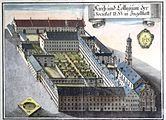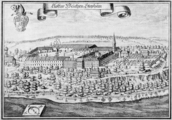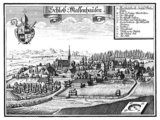Michael Wening
Michael Wening (born July 11, 1645 in Nuremberg , † April 18, 1718 in Munich ) was court copper engraver for Elector Ferdinand Maria of Bavaria and his successor, Elector Max Emanuel . Wening's main work Historico-Topographica Descriptio shows 846 topographical views of Bavaria and is considered to be the most comprehensive description of Europe in the early modern period .
Life
Michael Wening was born in Nuremberg in 1645 as the son of the pork butcher Balthasar Wening and his wife Katharina . There he learned the craft of copperplate engraving. There is evidence of his stay in Munich since 1669, after moving there from his hometown in 1668.
In Munich Wening converted from Protestantism to the Catholic Church. In 1671 he received the permanent residence permit with the citizenship of Munich and on January 27, 1671 married Anna Maria Mörl. Around the same time he found an irregular job at the court, where, as Fourier, he was responsible for organizing trips and receptions. In the following years Wening worked for different clients - even with small orders. After he had increasingly received orders as a copper engraver, he was appointed court copper engraver in 1675.
Wening had his own publishing house towards the end of the 1670s, in which he successfully published illustrated calendars for over ten years. A series of copperplate engravings that he published in 1680 on the occasion of the 18th birthday and the assumption of government of Elector Max Emanuel aroused his interest and led to the artist's success. In the same year Wening was awarded the court office of an electoral "knight's room porter".
During the Turkish wars , the engraver documented Elector Max Emanuel's war successes. During this time, Wening made many depictions of battles from the Turkish wars for Elector Max Emanuel, which are still valued by historians today because they illustrate the events of that time.
Major work Historico-Topographica Descriptio
At the beginning of 1696, Wening suggested to his elector that they publish a topographical work with views and descriptions of all cities, monasteries and palaces in Bavaria. Models were works such as the Topographia Germaniae by Matthäus Merian , the Austrian topographies by Georg Matthäus Vischer and the preliminary work on the Latin topography of Bavaria by Philipp Apian that was never printed .
After minor work, the engraver received in June 1696 from Elector Max Emanuel and the Bavarian landscape (the state estates ) a contract for the representation of all places in the four rent offices of Munich , Burghausen , Landshut and Straubing . Each of the four folio volumes, which appeared between 1701 and 1726, comprise one of these four tax offices. The judicial districts are dealt with in alphabetical order according to the government capital of the rent office. After the description of the seat of the court, cities and markets, monasteries and court brands follow . Wening's depictions of the palaces and manors of the Bavarian landed nobility also provide information about the role of the baroque gardens in Bavaria. Wening emphasized certain elements in the spirit of his client Max Emanuel, such as the depictions of the castles around Lake Starnberg , its magnificent ship Bucentaur or ships from his escort fleet.
The topographic views have different formats. Some of them come exclusively from Wening. They are partly based on older graphics and drawings that were made in his engraving workshop in Munich.
Having received an electoral patent, Wening began his journey through Bavaria on November 12, 1692 from Dachau . By January 1693 he is said to have mapped 131 locations. On November 2, 1701, the first volume of the Historico-topographica descriptio Bavariae was completed with the Munich Rent Office .
Wenings Historico-Topographica Descriptio , with its 846 views, is considered the most comprehensive description of Europe in the early modern period . The topographical work shows views and descriptions of the cities, markets, monasteries, palaces, castles, court marks and mansions in Bavaria. The accompanying texts were written by the Jesuit Ferdinand Schönwetter. His descriptions are valuable additions to Wening's prints.
The illustrations that Wening created himself on site are outstanding. Their great accuracy is extremely valuable for (art) historical research. The views of Bavarian monasteries should be emphasized because they reliably reflect the structural condition before the baroque redesigns and, on the other hand, depict unrealized building projects. Due to the representative character of the work, Wening decided to idealize images, for example with regard to the condition of the building structure and the gardens. The copper plates were handed over to the court in accordance with the contract, although payments were sometimes slow. This applies above all to the time of the occupation of Bavaria by Austrian troops during the War of the Spanish Succession . The associated economic decline, which severely restricted Wening's income opportunities, led him to complete his work at his own expense. The last few years have been marked by abject poverty.
Three of the four volumes of the Historico-Topographica Descriptio appeared only after his death. His heirs delivered the copper plates to the court in accordance with the contract. "Wening's topography became the culmination of Baroque visualization, of the land formed by the work and the will to express itself of its inhabitants and strewn with cities, gardens, churches, monasteries, castles and court marks."
Wening's copper plates are still state-owned. They are currently in the care of the State Office for Digitization, Broadband and Surveying .
literature
- Rainer Schuster: Michael Wening: his "Historico Topographica Descriptio" Upper and Lower Bavaria - requirements and history of origin -. Munich 1999, ISBN 3-87821-309-3 .
- Gertrud Stetter: Old Bavarian life on Wening engravings. Rosenheim 1977, ISBN 3-475-52202-0 .
Works (selection)
Deutenhofen Castle around 1700
City of Vilshofen on the Danube
Nymphenburg Palace in Munich
Old Academy in Munich
Wörthschlössl on the island of Wörth
Massenhausen Castle
Kranzberg Castle and District Court
Thalhausen Castle (Kranzberg)
Castle and market in Wörth on the Danube
Calvary in Lenggries
Individual evidence
- ↑ On the life of Michael Wening. In: State Office for Digitization, Broadband and Surveying. 2017, accessed November 12, 2017 .
- ^ Christoph Stölzl: Elector Max Emanuel: Bavaria and Europe around 1700. Exhibition catalog volume 2. Munich 1976 (p. 235).
- ^ Historical Hofmark - City of Eggenfelden. Retrieved November 30, 2019 .
literature
- Gertrud Stetter: Michael Wening, life and work of the engraver and topographer. Süddeutscher Verlag, Munich 1964.
Web links
- www.bavarikon.de - all stitches by Wening in high quality
- Wening town views - Bavarian Surveying Administration
- Literature by and about Michael Wening in the catalog of the German National Library
| personal data | |
|---|---|
| SURNAME | Wening, Michael |
| BRIEF DESCRIPTION | German engraver |
| DATE OF BIRTH | July 11, 1645 |
| PLACE OF BIRTH | Nuremberg |
| DATE OF DEATH | April 18, 1718 |
| Place of death | Munich |























